Hello, fellow innovators! Whether you’re a startup founder ready to disrupt the healthcare industry or a seasoned CIO/CTO looking for fresh insights, you’ve come to the right place. Today, we’ll unravel the complexity of creating an urgent care app, one step at a time. So, grab your coffee, and let’s dive in!
Top Takeaways:
- In the urgent care app development process, following the correct sequence of steps is crucial. That ensures that each aspect receives ample attention, from understanding user needs to safeguarding sensitive patient health information.
- Rather than jumping straight to the coding phase, focusing on pre-development steps like market research, requirement gathering, and prototyping can significantly influence the final product.
- It’s not just about developing generic healthcare apps; it’s about creating a unique tool that genuinely enhances the urgent care experience.
Table of Contents:
1. Understanding the Urgent Care App Market
2. Top Urgent Care App Features
3. Navigating Through Healthcare Regulations
4. 7 Steps to Make an Urgent Care App
- Step 1: Discovery
- Step 2: Rapid Prototyping
- Step 3: Develop a Proof of Concept
- Step 4: Develop a Minimum Viable Product
- Step 5: Apply HIPAA Security Standards
- Step 6: Rigorous Testing
- Step 7: Release and Maintain the App
5. Post-Launch Strategies for an Urgent Care Application
6. Estimating the Cost of Developing an Urgent Care App
7. Leveraging Topflight’s Expertise in Healthcare App Development
Unraveling the Urgent Care App Market
Understanding the landscape we’re venturing into is paramount before we delve into the urgent medical care app development process. The market size of the urgent care app market is expanding rapidly, powered by the omnipresence of smartphones and the escalating demand for easily accessible healthcare services. But what implications does this hold for you?
Market Dynamics: Anticipated Growth and Emerging Trends
As per a study by Grand View Research, the global digital health market is projected to touch $509.2 billion by 2025. This surge is propelled by the increasing adoption of sophisticated healthcare IT solutions and the burgeoning demand for remote patient monitoring services.
More specifically, the urgent care app segment is witnessing exceptional growth. According to Mordor Intelligence, the urgent care apps market is predicted to register a CAGR of 41.5% during 2021-2026, fueled by the mounting need for accessible, efficient, and cost-effective healthcare solutions. These promising figures indicate a tremendous opportunity for care providers to make a significant impact with an innovative urgent care solution.
Opportunity: The craving for digital health solutions is soaring. Consumers desire healthcare services at their fingertips, quite literally.
Competition: The market is brimming with mobile products providing a variety of medical services. To carve a niche, you’ll need to offer unique and valuable features specific to urgent care.
Regulation: Healthcare apps must adhere to stringent regulations like HIPAA and GDPR to safeguard patient data.
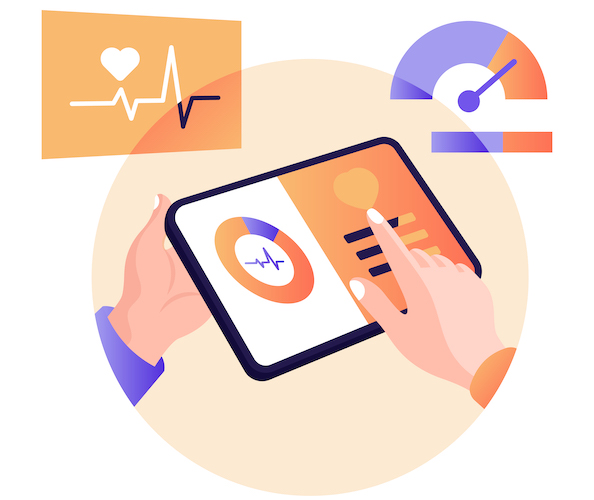
Key Use Cases for Urgent Care Apps
Entering this market necessitates identifying the principal use cases propelling the demand for urgent care applications. Most of them fall into three categories:
- Video consultations: Patients aspire to access medical advice without stepping out of their homes. Through urgent care apps, they can interact with doctors and nurse practitioners virtually via video calls for real-time diagnosis.
- Telemonitoring: Remote patient monitoring permits medical professionals to keep track of a patient’s health from afar, circumventing regular appointments. This technology mainly benefits individuals with chronic conditions who may require immediate and necessary care interventions.
- Self-care resources. From mindfulness applications to meditation tools, digital health solutions increasingly focus on self-care initiatives enabling users to take charge of their wellness. Such solutions can be integrated into an urgent care app to offer additional value.
In this booming market, healthcare website development also plays a critical role in reaching more patients and providing them with the necessary information and services. Incorporating urgent care software features into a healthcare website could be another strategic move in this digital health revolution.
Top Urgent Care App Features
As we explore the nuances of how you can create an urgent care app, it’s crucial to identify the features that should be included. While some are fundamental for a basic user experience, others can elevate your digital product and give it a competitive edge.
Essential Features
When you set out to make an urgent care app, at a minimum, it should include the following features:
- User Authentication
Allow users to access the app with their credentials securely. You can utilize third-party services like Google or Apple Sign-In to make the login process more user-friendly.
- Appointment Scheduling
To help patients efficiently manage their healthcare, your application should provide a quick way to schedule appointments with medical professionals. Include a calendar and an automated reminder system to minimize no-shows.
- Medical History-Taking Tool
A vital feature of any healthcare app is the ability to store and manage medical records. Before a consultation, patients should be able to conveniently share their symptoms through online triage. That ensures that healthcare providers are well-informed before the meeting, enabling them to provide better care.
- Messaging or Live Chat
Instant messaging enables seamless communication between users and healthcare providers, allowing them to ask questions and receive real-time answers. This option proves invaluable when a dedicated consultation session is not necessary.
- EHR Integration
To further help patients and their providers, integrate Electronic Health Records (EHR) into your solution. EHRs securely store patient information, such as allergies, medications, vaccination records, etc., in one place for easy access by healthcare providers during consultations.
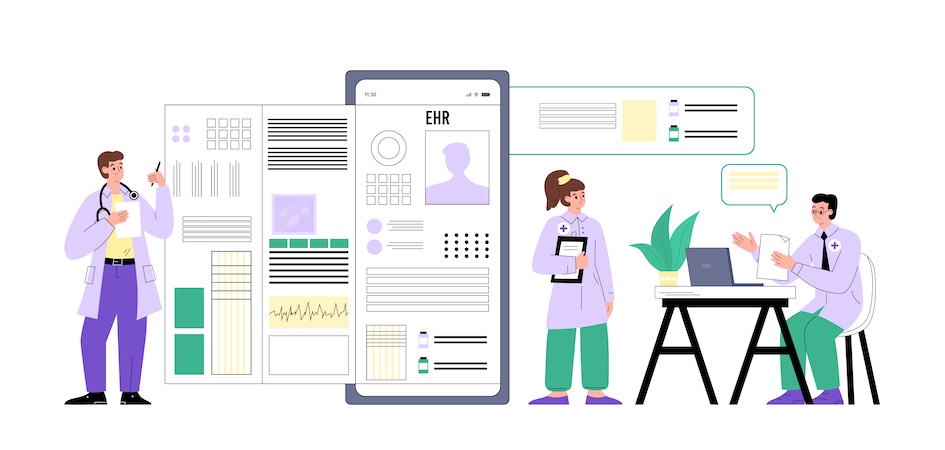
- Payment Processing
Enable secure payments for consultations and other services provided within the app to make it easier for patients to manage their healthcare expenses.
- Push Notifications
Sending timely reminders for medication intake, follow-ups, or appointments can significantly improve patient care and adherence to treatment plans. This minor feature can dramatically impact a patient’s health management journey.
Innovative features for a competitive edge
As healthcare providers increasingly turn to digital solutions, the role of health apps in delivering quality care has become indisputable. In addition to the core components, when embarking on healthcare app development, consider including the following innovative features to give your urgent care app a competitive edge:
- Wearable Device Integration
Through APIs from wearables like FitBit and Apple Watch, you can capture real-time data and track the user’s health over time. This integration provides healthcare providers with real-time insights into a user’s vitals, activity levels, and overall health status, enhancing the quality of virtual consultations.
- Virtual Waiting Room
This feature offers updates on wait times, helping manage expectations and reduce the frustration associated with long waits. A virtual waiting room respects the user’s time, allowing them to engage in other activities and return to the application when it’s time for their consultation, thus fostering a more efficient and patient-friendly experience.
- AI Chatbot
Leverage natural language processing capabilities to create an AI assistant that answers common questions about medical conditions and provides personalized recommendations. That is a significant advancement in health apps, enhancing user experience and providing instant support 24/7.
- Location Tracking
Incorporate geolocation services in your app to help users find the closest urgent care centers. Geolocation can also enable two-way communication between the app and urgent care centers, facilitating seamless transitions between consultations.
![]()
- Remote Monitoring
Integrating remote sensors with the app allows healthcare providers to monitor a patient’s vital signs in real-time, further enhancing the quality of care.
- Artificial Intelligence (AI) Engine
A well-trained AI engine can analyze patients’ self-reported symptoms and provide preliminary diagnoses. By leveraging machine learning algorithms, the system can learn from thousands of previous cases by leveraging machine learning algorithms to produce more accurate results.
AI can aid in identifying potential health issues and suggest next steps for patients, providing them with a referral or redirecting them to an emergency care center on the spot.
While these features are not mandatory, they can set your application apart from competitors and make the user experience more engaging and informative. Remember, every option you add during the healthcare app development process should enhance the value of your urgent care app and fulfill a specific user need or solve a pressing problem.
Urgent care apps rely on fast access to data, which a specialized custom mobile application development company can offer.
Navigating Through Healthcare Regulations
Setting up an urgent care app, or any healthcare mobile application, is filled with unique challenges. You must develop an intuitive interface, include features that provide users value, and comply with strict healthcare regulations like HIPAA and GDPR.
Complying with HIPAA in the US
When you set up an urgent care app in the US, adhering to the Health Insurance Portability and Accountability Act (HIPAA) is crucial. This regulation ensures patient data security by requiring companies to adopt administrative safeguards.
These may include encrypting data, restricting access to authorized personnel only, regularly auditing logs for suspicious activity, and more. For instance, compliance with HIPAA is a must when dealing with sensitive information like real-time test results.
Meeting GDPR standards in the EU
Conversely, if your mobile solution caters to European Union citizens, you must meet the General Data Protection Regulation (GDPR) standards. This law sets guidelines for how companies collect and handle personal data. It requires companies to inform users about the data they’re collecting, obtain explicit consent to use it, and provide an easy way for users to access and delete their data.
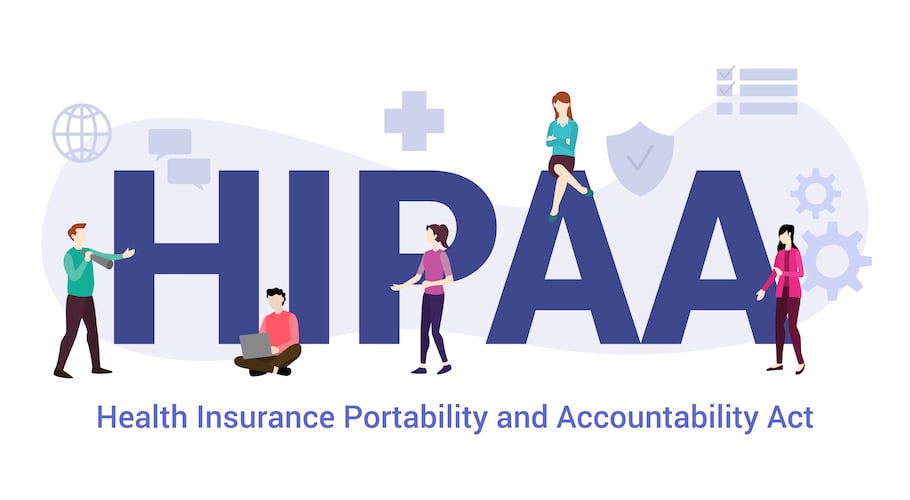 Failure to comply with these regulations can lead to substantial fines and penalties, whether you are developing hospital apps or other healthcare mobile applications. Therefore, it’s essential to consult a lawyer or a healthcare IT specialist during the app development process.
Failure to comply with these regulations can lead to substantial fines and penalties, whether you are developing hospital apps or other healthcare mobile applications. Therefore, it’s essential to consult a lawyer or a healthcare IT specialist during the app development process.
7 Steps to Make an Urgent Care App
Embarking on healthcare app development, particularly to create an urgent medical care app, is a significant undertaking. It requires experienced app developers well-versed in the latest technologies, a robust infrastructure to support your application, and knowledgeable advisers to help navigate complex regulations.
Here’s a step-by-step guide to mobile app development specifically for an urgent care app:
| Step | Description | Key Roles |
|---|---|---|
| 1. Discovery | Define goals, research target audience, identify key use cases, and select a tech stack to guide the development process. |
|
| 2. Rapid Prototyping | Design an interactive visual prototype to validate app design and functionality cost-effectively. |
|
| 3. Develop a Proof of Concept | Create a simplified app version focusing on a key feature to validate its feasibility and gather user feedback. |
|
| 4. Develop a Minimum Viable Product | Build an MVP with essential features to launch quickly, gather feedback, and iteratively improve the app. |
|
| 5. Apply HIPAA Security Standards | Ensure data security with HIPAA compliance measures like encryption, access restrictions, and regular audits. |
|
| 6. Rigorous Testing | Conduct automated and manual testing to ensure functionality, performance, and a seamless user experience. |
|
| 7. Release and Maintain the App | Launch the app, plan for scalability, and provide regular updates and bug fixes to ensure optimal performance. |
|
Step 1: Discovery
At this initial stage of healthcare app development services, it’s essential to clearly outline your goals and objectives.
Research your target audience, identify their pain points, and understand how your app can address them. Identifying key use cases for your application will guide your development process.
Choosing an appropriate tech stack also falls within this stage, as the selected technologies will significantly influence the app’s performance and user experience.
Roles required:
- product manager
- software architect
- business analyst
Step 2: Rapid Prototyping
Once you’ve established a clear direction for your app, rapid prototyping is the next step in mobile app development. This involves designing an interactive visual prototype of your solution that you can share with potential users for feedback. It’s a cost-effective way to validate a medical app design and functionality before moving on to full-scale development.
Roles required:
- product manager
- UX engineer
- designer/s
Step 3: Develop a Proof of Concept
On your journey to build an urgent care app, developing a proof of concept (PoC) is crucial. A PoC is a simplified version of your app, typically focusing on one key feature – this could be anything from scheduling appointments to mental health resources.
More on the specifics of creating an app for mental health in our dedicated blog.
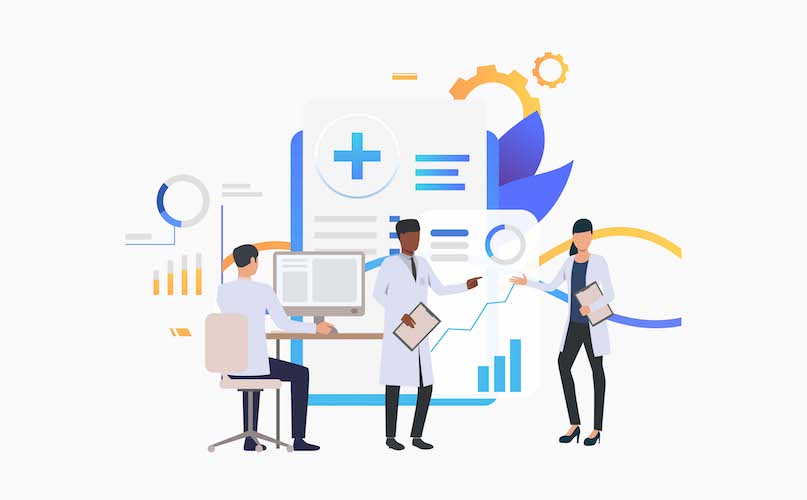
The purpose of a PoC is to test the viability of your idea with real customers. It’s a valuable tool for gathering user feedback and identifying potential issues before investing too much time and resources in development.
Roles required:
- product manager
- project manager
- full-stack developer/s
- mobile developer/s
- business analyst
Step 4: Develop a Minimum Viable Product
A minimum viable product (MVP) is a version of your application that includes only the essential features needed to solve a specific problem for your users. Treat your MVP as an upgrade to the PoC, adding more features to reach a more balanced product-market fit.
Developing an MVP allows you to quickly launch your app, gather valuable user feedback, and iteratively improve your product based on real-world usage – an approach favored by many successful healthcare organizations.
Roles required:
- product manager
- project manager
- full-stack developer/s
- mobile developer/s
- QA engineer/s
Step 5: Apply HIPAA Security Standards
When setting out to develop an urgent care app, compliance with HIPAA security standards is a must. These standards ensure patient data is handled securely, with measures such as data encryption, access restriction to authorized personnel, and regular auditing of logs for any suspicious activity.
Roles required:
- project manager
- full-stack developer/s
- mobile developer/s
- HIPAA compliance expert
- DevOps engineer
I advise you to read up on HIPAA compliant app development in one of our recent posts.
Step 6: Rigorous Testing
Once you’ve applied the necessary HIPAA safeguards while building an urgent care app, rigorous testing becomes crucial. Customers always appreciate applications that function as intended and provide a seamless user experience.
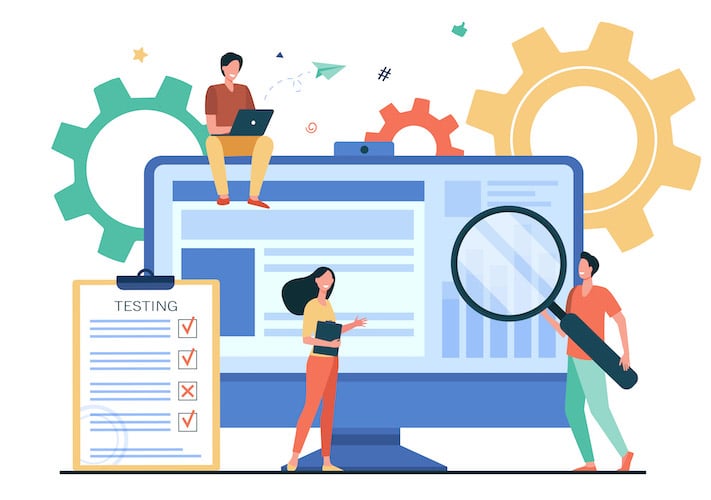
When it comes to healthcare app development, establishing a DevOps environment for automated testing and continuous integration is essential. It facilitates faster bug detection and resolution.
Roles required:
- project manager
- full-stack developer/s
- mobile developer/s
- QA engineer/s
Step 7: Release and Maintain the App
The final stage involves releasing your app to the public and maintaining it for optimal performance. Given the dynamic nature of application development, planning for scalability is crucial. Your user base may grow over time, and the product should be able to handle increased traffic.
Extrapolating the number of users at different product stages (PoC > MVP) must have been your primary focus during the discovery stage of the telehealth app development services.
Regular updates and bug fixes are also part of this stage, ensuring your app stays relevant and reliable for your users.
Post-Launch Strategies for an Urgent Care Application
Once you’ve managed to launch an urgent care app, the next step is to drive customers to it and ensure its success in the market. Here are some tips for post-launch strategies that can be used to maximize your app’s reach and engagement.
Market Your App
Promote your application through social media, online advertising, and content marketing. Focus on targeting potential users who could benefit from your app, particularly those managing specific health conditions like blood pressure monitoring.
Analyze Customer Behavior
Use analytics tools to monitor user interactions with your app, such as feature usage, engagement levels, retention rates, and more. That way, you’ll gain invaluable insights that can help inform future development decisions.
Improve the App Experience
Listen to user feedback and incorporate suggestions into your app to enhance the user experience. You can also use A/B testing strategies to experiment with different features, functions, and UI design elements.
Get Reviews & Ratings
Encourage users to leave ratings and reviews on app stores. Positive user reviews will boost your app’s visibility and make it more attractive to potential new customers. Ensure that any negative feedback is promptly directed to your support team, bypassing the App Store and Google Play. As for positive reviews with 4 and 5 stars, they should go directly to the mobile stores.
![]() Walker Tracker from our portfolio after a major revamp
Walker Tracker from our portfolio after a major revamp
Invest in User Education
Create tutorials, FAQs, and other educational materials to help users understand the main features of your app. This will increase user adoption and engagement and provide patients with the necessary knowledge to fully utilize the application.
By taking a proactive approach to post-launch strategies after the MVP part of telehealth app development is over, you can ensure that your urgent care app is successful in the market and continues to provide value for its users.
Estimating the Cost of Developing an Urgent Care App
When planning your urgent care application development project, it’s important to consider the healthcare app development cost. Factors such as the project’s complexity, the size of your team, and the technologies used can all significantly impact costs.
Knowing how much you need to budget for your app will help you make informed decisions and ensure you’re making the most of your resources.
To accurately estimate the healthcare app development cost of an urgent care app, consider the following factors:
- The Complexity of Features: More complex features require more time and resources to develop, which increases costs.
- The Size of the Development Team: A larger team requires more resources, leading to higher costs.
- The Technologies Used: Different technologies come with different licensing fees and have varying levels of complexity that can impact the cost of development.
To create an accurate budget for your app development project, it’s crucial to also factor in post-launch maintenance costs, such as hosting fees, bug fixes, and updates.
Based on our experience, the cost of launching a Minimum Viable Product (MVP) of an urgent care app should be in the $80,000 — $150,000 range.
We understand that times are tough for medical practices, so we want to make it easier for them to access our healthcare application development services.
We offer custom plans and flexible terms to meet their specific needs and budgets. Our team can also help them create a roadmap that outlines their project’s timeline, budget, and other factors. As a result, founders get the information they need to make informed decisions regarding their urgent care app development project.
Leveraging Topflight’s Expertise in Healthcare App Development
At Topflight, we specialize in developing high-performance healthcare applications that provide real value to users. Our team has extensive knowledge and expertise in building secure, compliant, and reliable healthcare apps for a wide range of organizations, including hospitals, clinics, pharma companies, and medical practices.
Symptom-tracking apps
Smarter Symptom Tracker is a web and mobile app from the TMJ & Sleep Therapy Centre Of San Francisco for pain and sleep disorders. Dr. Jamil Alkhoury, the clinic’s founder, contacted us to develop an iOS, Android, and web application. The mobile app is for the clinic’s patients to record and track their progress, refill prescriptions, message their doctors, keep diaries during treatment, and visualize their health. The web app allows doctors to monitor their patient’s progress and identify clinically-significant health changes that signal the need for a return visit.
Doctor-on-demand apps
After four years in medical staffing, Kinesio Rehab decided the space could use a massive digital revamp: agencies and clinicians deserved a simpler life. To help the company bring healthcare staffing agencies and clinicians together on a single platform, Topflight built a B2B marketplace, Visitry. This initiative is part of their broader vision for doctor on-demand app development, aiming to simplify and enhance the digital healthcare landscape.
Remote care apps
Allheartz ushers physical therapy and sports care into the 21st century by introducing a software platform for Remote Therapeutic Monitoring. The RTM platform automates menial work for doctors and coaches and leverages AI to speed up recovery for patients and athletes.
Medical apps leveraging location tracking
Our work with Medable through the Stanford University School of Medicine was to develop a HIPAA-compliant custom dashboard on iOS and Android phones to visualize collected data and provide feedback to participants in the iFaint study. One of the app’s requirements is to detect when a user is near a hospital for a certain period of time and then fire a notification asking if the reason for the hospital visit is related to the study.
We understand the unique requirements of healthcare IT projects and have a track record of successful deployments. We use agile development strategies to ensure rapid delivery of high-quality products that meet the specific needs of healthcare organizations. Our team can help you create an application that meets all regulatory requirements and provides a seamless user experience.
If you plan to start an urgent care app, contact Topflight today to discuss your project! We’ll happily provide support and guidance throughout the process, from the initial concept to the final launch. Our experienced professionals can help you create an app that will make a difference in people’s lives.
Our team is committed to delivering top-notch healthcare solutions and ensuring customer satisfaction every step of the way. With our expertise, you can rest assured that your urgent care app will be built with accuracy and precision, resulting in a product you can be proud of.
Frequently Asked Questions
What are the benefits of developing an urgent care app?
An urgent care app can provide numerous benefits for medical practices, including increased efficiency and improved patient satisfaction. It can also enable medical teams to stay connected with patients in real time and respond quickly to queries or requests.
What technologies do you use for urgent care app development?
We use a range of technologies depending on the needs of our clients. That includes web technologies such as HTML, CSS, JavaScript, and other frameworks like React.js and Angular.js; mobile technologies such as Swift and Kotlin for iOS and Android apps; backend technologies such as Node.js and Python; and cloud services from AWS or Azure.
What do you need to develop an urgent care app?
We typically require a detailed project plan from the client that outlines the project requirements, budget, timeline, and other essential information. This helps us develop an accurate estimate of the cost and timeline for your project. Additionally, we’ll need access to the app’s relevant data or databases.
How much does it cost to develop an urgent care app?
The cost of developing an urgent care app will depend on complexity. We offer custom plans and flexible terms to meet our clients’ needs and budgets. Our team is dedicated to helping you create products that meet your objectives without breaking the bank. Contact us today for a free quote!
What makes Topflight a good choice for urgent care application development?
Topflight is an experienced healthcare application development company with a proven track record of successful deployments. We understand the unique requirements of healthcare IT projects and have the expertise to create secure, compliant, and reliable apps that meet the specific needs of medical teams. Our team is committed to delivering top-notch healthcare solutions and ensuring customer satisfaction every step of the way. With our help, you can create an app that makes a difference in people’s lives.